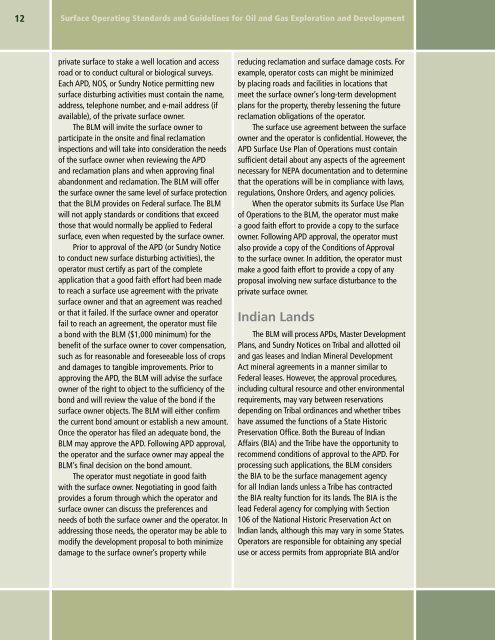Download the Gold Book (pdf 6.3 mb) - Bureau of Land Management
Download the Gold Book (pdf 6.3 mb) - Bureau of Land Management
Download the Gold Book (pdf 6.3 mb) - Bureau of Land Management
Create successful ePaper yourself
Turn your PDF publications into a flip-book with our unique Google optimized e-Paper software.
Surface Operating Standards and Guidelines for Oil and Gas Exploration and Development<br />
private surface to stake a well location and access<br />
road or to conduct cultural or biological surveys.<br />
Each APD, NOS, or Sundry Notice permitting new<br />
surface disturbing activities must contain <strong>the</strong> name,<br />
address, telephone nu<strong>mb</strong>er, and e-mail address (if<br />
available), <strong>of</strong> <strong>the</strong> private surface owner.<br />
The BLM will invite <strong>the</strong> surface owner to<br />
participate in <strong>the</strong> onsite and final reclamation<br />
inspections and will take into consideration <strong>the</strong> needs<br />
<strong>of</strong> <strong>the</strong> surface owner when reviewing <strong>the</strong> APD<br />
and reclamation plans and when approving final<br />
abandonment and reclamation. The BLM will <strong>of</strong>fer<br />
<strong>the</strong> surface owner <strong>the</strong> same level <strong>of</strong> surface protection<br />
that <strong>the</strong> BLM provides on Federal surface. The BLM<br />
will not apply standards or conditions that exceed<br />
those that would normally be applied to Federal<br />
surface, even when requested by <strong>the</strong> surface owner.<br />
Prior to approval <strong>of</strong> <strong>the</strong> APD (or Sundry Notice<br />
to conduct new surface disturbing activities), <strong>the</strong><br />
operator must certify as part <strong>of</strong> <strong>the</strong> complete<br />
application that a good faith effort had been made<br />
to reach a surface use agreement with <strong>the</strong> private<br />
surface owner and that an agreement was reached<br />
or that it failed. If <strong>the</strong> surface owner and operator<br />
fail to reach an agreement, <strong>the</strong> operator must file<br />
a bond with <strong>the</strong> BLM ($1,000 minimum) for <strong>the</strong><br />
benefit <strong>of</strong> <strong>the</strong> surface owner to cover compensation,<br />
such as for reasonable and foreseeable loss <strong>of</strong> crops<br />
and damages to tangible improvements. Prior to<br />
approving <strong>the</strong> APD, <strong>the</strong> BLM will advise <strong>the</strong> surface<br />
owner <strong>of</strong> <strong>the</strong> right to object to <strong>the</strong> sufficiency <strong>of</strong> <strong>the</strong><br />
bond and will review <strong>the</strong> value <strong>of</strong> <strong>the</strong> bond if <strong>the</strong><br />
surface owner objects. The BLM will ei<strong>the</strong>r confirm<br />
<strong>the</strong> current bond amount or establish a new amount.<br />
Once <strong>the</strong> operator has filed an adequate bond, <strong>the</strong><br />
BLM may approve <strong>the</strong> APD. Following APD approval,<br />
<strong>the</strong> operator and <strong>the</strong> surface owner may appeal <strong>the</strong><br />
BLM’s final decision on <strong>the</strong> bond amount.<br />
The operator must negotiate in good faith<br />
with <strong>the</strong> surface owner. Negotiating in good faith<br />
provides a forum through which <strong>the</strong> operator and<br />
surface owner can discuss <strong>the</strong> preferences and<br />
needs <strong>of</strong> both <strong>the</strong> surface owner and <strong>the</strong> operator. In<br />
addressing those needs, <strong>the</strong> operator may be able to<br />
modify <strong>the</strong> development proposal to both minimize<br />
damage to <strong>the</strong> surface owner’s property while<br />
reducing reclamation and surface damage costs. For<br />
example, operator costs can might be minimized<br />
by placing roads and facilities in locations that<br />
meet <strong>the</strong> surface owner’s long-term development<br />
plans for <strong>the</strong> property, <strong>the</strong>reby lessening <strong>the</strong> future<br />
reclamation obligations <strong>of</strong> <strong>the</strong> operator.<br />
The surface use agreement between <strong>the</strong> surface<br />
owner and <strong>the</strong> operator is confidential. However, <strong>the</strong><br />
APD Surface Use Plan <strong>of</strong> Operations must contain<br />
sufficient detail about any aspects <strong>of</strong> <strong>the</strong> agreement<br />
necessary for NEPA documentation and to determine<br />
that <strong>the</strong> operations will be in compliance with laws,<br />
regulations, Onshore Orders, and agency policies.<br />
When <strong>the</strong> operator submits its Surface Use Plan<br />
<strong>of</strong> Operations to <strong>the</strong> BLM, <strong>the</strong> operator must make<br />
a good faith effort to provide a copy to <strong>the</strong> surface<br />
owner. Following APD approval, <strong>the</strong> operator must<br />
also provide a copy <strong>of</strong> <strong>the</strong> Conditions <strong>of</strong> Approval<br />
to <strong>the</strong> surface owner. In addition, <strong>the</strong> operator must<br />
make a good faith effort to provide a copy <strong>of</strong> any<br />
proposal involving new surface disturbance to <strong>the</strong><br />
private surface owner.<br />
Indian <strong>Land</strong>s<br />
The BLM will process APDs, Master Development<br />
Plans, and Sundry Notices on Tribal and allotted oil<br />
and gas leases and Indian Mineral Development<br />
Act mineral agreements in a manner similar to<br />
Federal leases. However, <strong>the</strong> approval procedures,<br />
including cultural resource and o<strong>the</strong>r environmental<br />
requirements, may vary between reservations<br />
depending on Tribal ordinances and whe<strong>the</strong>r tribes<br />
have assumed <strong>the</strong> functions <strong>of</strong> a State Historic<br />
Preservation Office. Both <strong>the</strong> <strong>Bureau</strong> <strong>of</strong> Indian<br />
Affairs (BIA) and <strong>the</strong> Tribe have <strong>the</strong> opportunity to<br />
recommend conditions <strong>of</strong> approval to <strong>the</strong> APD. For<br />
processing such applications, <strong>the</strong> BLM considers<br />
<strong>the</strong> BIA to be <strong>the</strong> surface management agency<br />
for all Indian lands unless a Tribe has contracted<br />
<strong>the</strong> BIA realty function for its lands. The BIA is <strong>the</strong><br />
lead Federal agency for complying with Section<br />
106 <strong>of</strong> <strong>the</strong> National Historic Preservation Act on<br />
Indian lands, although this may vary in some States.<br />
Operators are responsible for obtaining any special<br />
use or access permits from appropriate BIA and/or

















